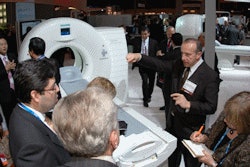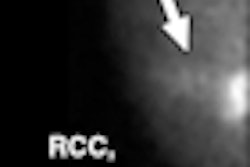CHICAGO - A new computer-aided detection (CAD) technique shows promise for improving sensitivity for detecting breast masses on mammograms, according to research from the University of Michigan Medical School (UMMS) in Ann Arbor, MI.
"A four-view CAD system significantly improved the accuracy for mass detection on mammograms," said Jun Wei, Ph.D. He presented the study team's research at the 2008 RSNA meeting in Chicago.
Screening mammography performed using two views (mediolateral oblique and craniocaudal) from both breasts has been shown to increase cancer detection sensitivity. Following up on previous research that found improved detection accuracy with both two-view analysis and bilateral analysis, the UMMS researchers sought to develop a four-view CAD system that emulates radiologist reading practices by using two breast views to reduce false positives, Wei said.
The four-view system includes three steps. First, the institution's previously developed dual-system approach is used to independently identify mass candidates on each view, resulting in an estimated mass likelihood score for each candidate.
The CAD scheme then utilizes two-view analysis and bilateral analysis to emulate radiologists' reading process, using the two views of the same breast to reduce false positives and the bilateral views to detect asymmetry, according to the researchers. In the two-view analysis, a two-view score of each candidate was generated by registering candidate pairs and fusing the pair's information with a similarity classifier.
In the bilateral analysis phase, the corresponding region on the contralateral mammogram of the same view is identified for each mass candidate; the asymmetry of the density patterns is then analyzed by an asymmetry classifier to generate a bilateral score for each candidate.
The third step involves linear discriminant analysis (LDA), in which an LDA classifier is trained to merge the single-view mass likelihood score, two-view score, and bilateral score for each candidate and to differentiate true masses from false positives, according to the study team.
To test the four-view system, the researchers gathered two datasets of film mammograms, including a set of 389 mass cases (168 malignant, 221 benign) and a set of 200 normal patients. Each patient had two views (craniocaudal and mediolateral oblique) for each breast.
The location of the index masses for the mass cases was identified by an experienced radiologist. The mass set was then randomly divided into two independent sets for cross-validation training and testing. The normal set was used only to identify false-positive rates during testing, according to the study team.
The four-view approach yielded false-positive rates of 1.04, 0.80, and 0.6 per image at case-based sensitivities of 90%, 85%, and 80%, respectively. In comparison, the single-view CAD system had false-positive rates of 1.75, 1.48, and 1.15 per image, respectively. Free-response receiver operating characteristic (FROC) analysis found the difference to be statistically significant (p < 0.05).
Further work is under way to enhance detection by improving each stage of the CAD system, Wei said.
By Erik L. Ridley
AuntMinnie.com staff writer
December 2, 2008
Related Reading
NEJM study finds single reading with mammo CAD matches double reading, October 2, 2008
Study finds that CAD improves mammography's sensitivity, February 13, 2008
Mammo CAD results show reproducibility in serial exams, January 10, 2008
UnitedHealthcare postpones CAD decision, November 27, 2007
CAD vs. radiologist second reads: What's better for screening mammograms? November 16, 2007
Copyright © 2008 AuntMinnie.com




















